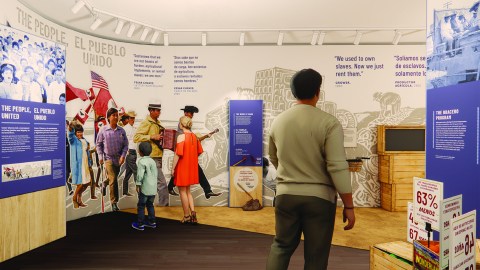MetLife Foundation, EmcArts and AAM issued a press release yesterday, announcing the second round of participants in Innovation Lab for Museums. I’m pleased that these three projects continue the pattern, established in round one, of innovating around issues that confront many of their peers.
Children’s museums face particularly daunting and complex challenges in coming decades, as recognized by the Association of Children’s Museums’ “Reimagining Children’s Museums” initiative (also funded by the MetLife Foundation, BTW). Many communities served by existing children’s museums have declining birth rates, and where population are growing, this growth is taking place among cultural & ethnic groups (mostly Latino) that have not traditionally been the primary users of museums, children’s or other. Also, the “Great Recession” has disproportionately affected younger adults (and parents with young children), who are likely to make museum membership decisions based on value-for-money (See Reach Advisor’s blog for posts on this subject). For this reason, among others, I’m happy that one of our three funded projects in round two is The Madison Children’s Museum’s “KidShare: Collecting, Presenting, and Preserving Children’s Culture and Creativity.” The central goal of this project is to prototype a system for helping kids and classroom teachers conduct fieldwork, and share them with the larger community. KidShare has the potential to provide new models for intertwining museums, students, schools and communities. I think this could help children’s museums to cultivate new audiences, as well.
While the demographic and cultural trends affecting children’s museums are just beginning to lap at their toes, historic house museums are already immersed in their challenging future. The National Trust for Historic Preservation documented this in detail in their 2007 Final Conference Report Sustainability of Historic Sites in the 21st Century. “At a time when the market for heritage tourism, cultural tourism, and eco-tourism is rapidly expanding, historic sites are drawing fewer and fewer visitors,” notes the report. “…historic sites seem to have lost their way. How should the historic site profession (that unique cross section of public history and museum studies) respond to this situation?” “Historic sites must no longer think of the “velvet rope tour” as their “basic bread and butter” program,” the report concludes, “and must generate more varied ways to utilize their remarkable resources to enrich people’s lives.” Therefore it is highly appropriate that the National Trust should conceive “Re-imagining Historic House Museums” for their innovation project. I fervently hope that the Lab helps the Trust achieve its goal of “creating house museums that inform, illuminate and inspire.”
While the Madison Children’s Museum and the National Trust projects have the potential to benefit their disciplines, the third funded project in round two tackles an issue that challenges the museum field as a whole: our out-dated membership model. As the Mississippi Museum of Art’s project proposal notes, the museum field has build org charts, software systems—a whole infrastructure—around the assumption that the traditional membership model is THE way to monetize individual participation. This model, however, is increasingly out of sync with the behavior of new audiences that are young, mobile and new to museums. “Our business model is based on behavior of the past,” MMA observes, “while our programming is based on behavior today.” I look forward to their experiments with “Unpacking Museum Membership: A new model for participation.”
As in round one, there were more worthy projects than could be funded even with MetLife’s generous support. On the recommendation of the selection panel, AAM is designating the McKissick Museum’s “The University Museum as Social Entrepreneur” as an “Innovation Project of Excellence,” in the hope that this will help the museum in its quest to explore how university museums can leverage faculty expertise to tackle community challenges while contributing to the museum’s sustainability. I am particularly eager to see this project go forward, since it focuses, in part, on community foodways and heritage foods to help tackle economic and health challenges of the region. (See CFM’s ongoing Feeding the Spirit initiative for more on this subject.)
I look forward to sharing news and reports from the three new Lab participants as they move the program, as well as keeping you updated on the progress of our round one museums.
And a big shout out and my personal thanks to these fabulous individuals, who served as selection panelists for this round of applications to Innovation Lab for Museums:
- Sebastian Chan, director of digital & emerging media, Cooper-Hewitt Design Museum, N.Y.
- Karen Coltrane, president & CEO, Children’s Museum of Richmond, Va.
- Georgina Bath Goodlander, interpretive programs manager, Luce Foundation Center for American Art, Smithsonian American Art Museum, Washington, D.C.
- Scott Kratz, vice president for education, National Building Museum, Washington, D.C.
- Maria Mortati, founder, San Francisco Mobile Museum








One way to invigorate the museum experience is to make it interactive, with digital walking tours that one can access on a tablet or mobile device. This allows for additional data from the museums collection to be shared, including video and audio clips and links to more information. Once a museum's dormant collection is digitized it can be re-purposed and "monetized" via several models including licensing and downloadable apps.
Without sounding like a talking billboard, there is a company that does just this for museums – MediaMine.
I'd agree with that approach and would refer people to the Smithsonian's work in this area. The virtual tour at the Natural History Museum is a notable example of applying this technology. The web traffic has been so good that you can now just search on "Smithsonian" & "tour" and it comes up near the top of the search list. Ironically, the word "virtual" dropped in importance. The direct link is
http://www.mnh.si.edu/panoramas/
The tour was just upgraded and is now one of the more comprehensive examples on the web. Check it out.